Introduction
Coronavirus is a re-emerging infectious disease belonging to coronoviradae family and Nidovirales order. Human coronavirus was first identified in the mid-1960s. Six types of corona viruses were already known to the world. The SARS-CoV-2 is a new virus and the seventh corona virus, never seen before in people. It is different than other human coronaviruses that causes the common cold [1]. In December 2019, infection was originated as series of pneumonia cases of unknown origin in Wuhan, Hubei, China with clinical presentation resembling viral pneumonia [2]. Those cases were linked with Huanan seafood wholesale market of Wuhan which was later identified as a coronavirus disease. It has been noted that the newly identified coronavirus is similar to bat coronavirus and SARS-CoV-1 [3]. From a study in China, researchers have found that there are two types of coronavirus strains called as “L” and “S” types [4]. Coronavirus was also the causative agent of SARS (with 774 deaths from 8094 confirmed cases) and MERS (with 858 deaths from 2494 confirmed cases), but case fatality rate was high as compared to COVID-19. On February 11, 2020, the World Health Organisation named the disease coronavirus disease 2019 (abbreviated “COVID-19” SARS-CoV-2).
Timeline of Covid-19 Disease
First case of the disease was reported in Wuhan City, Hubei Province, China [5] on 31st December, 2019. Then, the disease started spreading rapidly with the following timeline:
9th January 2020- WHO announced that a novel coronavirus that has not previously been identified in humans which was detected in samples taken from patients in Wuhan City [6].
11th January 2020- First death reported in Wuhan city because of Coronavirus disease 2019.
26th January 2020-Confirmed cases of COVID-19 have been reported in many countries, including China, Hong Kong, Macau, Taiwan, Australia, France, Japan, Malaysia, Nepal, Singapore, Thailand, The Republic of Korea, United States, Vietnam [Table/Fig-1] [7,8].
Timeline of early stages of COVID-19 outbreak.
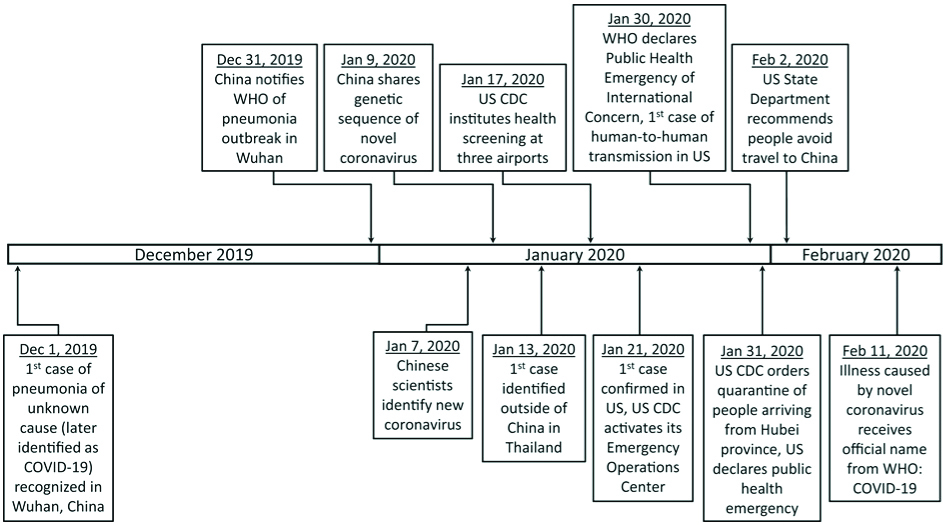
On 27th January 2020- 41 travel-related cases were identified and travelled back to their countries, 27 cases to Asia, six to North America, five to Oceania, and three to Europe [9].
On 30th January, 2020- United States reported the first confirmed case and on the same day, the International Health Regulations Emergency Committee of WHO declared the outbreak as a “PHEIC”
On 6th February, 2020-in 24 countries other than China, minimum of 216 cases have been confirmed: Germany, Australia, Cambodia, Vietnam, Canada, Finland, France, India, United Arab Emirates, Japan, Malaysia, Thailand, Nepal, The Philippines, Russia, Singapore, Belgium, South Korea, Spain, Sri Lanka, Sweden, Italy, United Kingdom and United States, . Two deaths have now been reported outside of mainland China (one in Hong Kong and one in Philippines) [10].
On 11th March 2020- WHO declares COVID-19, a pandemic.
On 30th March 2020- Globally total confirmed cases were 638,146; total deaths were 30,039 in 203 countries/areas/territories. Majority of cases were from United States of America (103,321 confirmed cases and 1,668 deaths), Italy (92,472 confirmed cases and 10,023 deaths) and China (82,356 confirmed cases and 3,306 deaths) [11].
Progression of Coronavirus Disease in India
On 30th January 2020- A student returned to Kerala, India from Wuhan, China on 24 January, who later found to be positive after testing. Subsequently, two more cases of COVID-19 were reported in the same city [12].
On 27th February 2020- One hundred and twenty four Indian passengers were evacuated from Japan and they were quarantined for 14 days [13].
On 14th March 2020- Total confirmed cases reached to 84 (67 Indian nationals and 17 foreign nationals) and two deaths (76-year-old male from Karnataka and 68-year-old female from Delhi). Till 22nd March, confirmed cases increased upto 360 and seven deaths in cities like Maharashtra (two deaths), Delhi (one death), Bihar (one death), Gujrat (one death), Karnataka (one death) and Punjab (one death) [14].
On 22nd March 2020- Hon’ble Prime Minister made a public appeal to encourage community participation in the response towards COVID-19 by observing a ‘Janta curfew’ on 22nd March from 7 am to 9 pm, later on 25th March 2020 he issued an order for all states/UTs prescribing a lockdown for containment of COVID-19 epidemic in the country for 21 days starting from 25th March [Table/Fig-2] [15].
Confirmed new cases/recovered/ deaths because of COVID-19 in India.
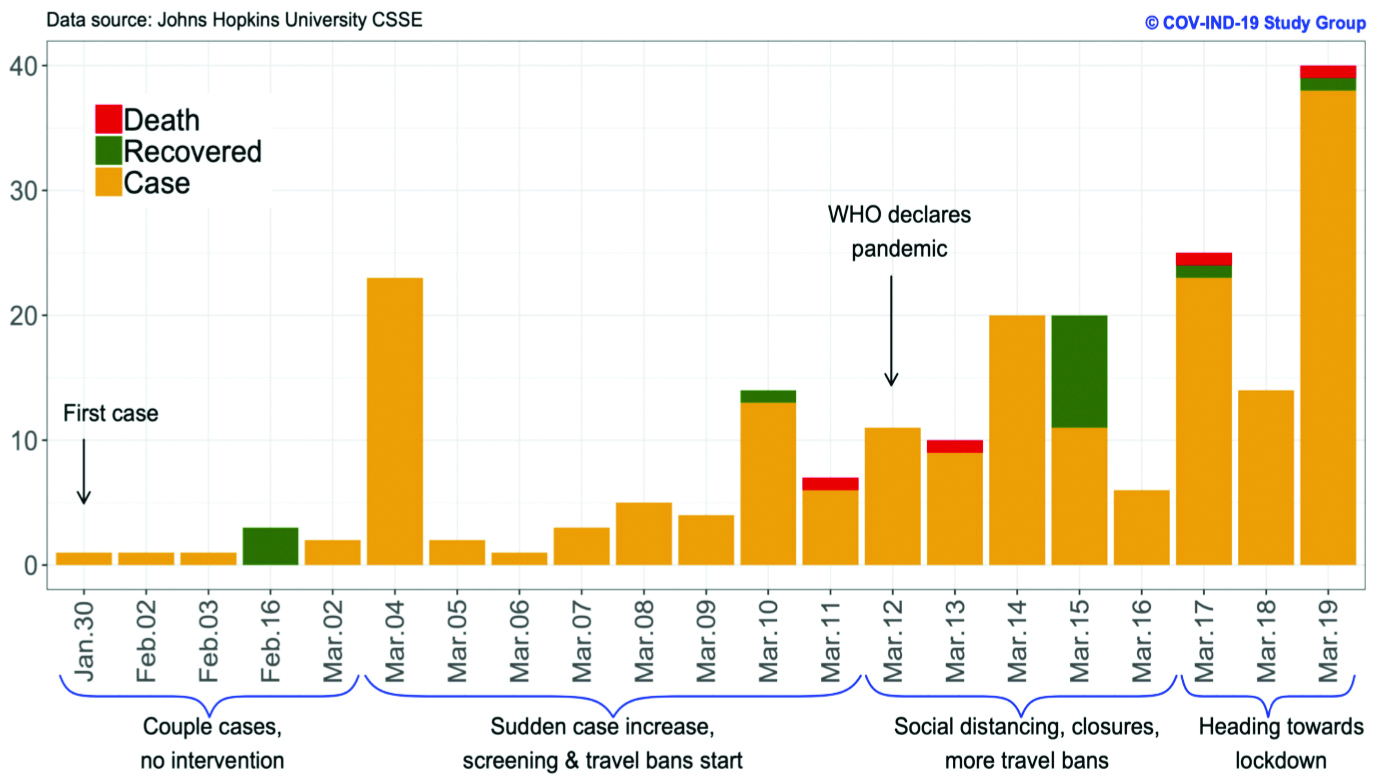
As of 3rd June, according to the Ministry of Health and Family Welfare (MOHFW), a total of 101,497 cases were confirmed, 100,302 recovered and 5,815 reported deaths [16].
The outbreak of SARS-CoV in 2002-2003 in Guangdong province, China and then 10 years later in 2012, MERS-Cov was identified. In both the cases, bats were considered as a natural host of these viruses. They transmit the infection to humans by using camels and civet cats as an intermediate host [Table/Fig-3] [17,18].
Potential animal origin of human coronaviruses [17,18].
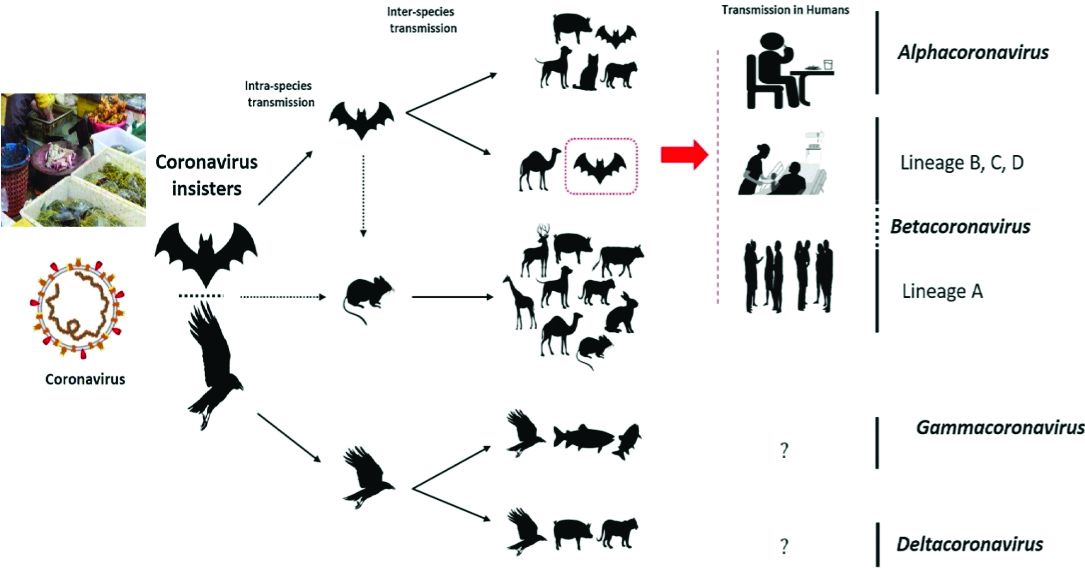
Historical Perspective
According to recent data, bats, fish, shellfish, porcupines and snakes are the most probable initial source of the current SARS-CoV-2 outbreak, that begun in December 2019 in Wuhan, China, apparently spreading from a “wet market/ Huanan Sea food market” to multiple cities and provinces in China [19-21].
Agent Factors
Because of crown-like spikes on its surfaces the virus got the name ‘Coronavirus’. It is an enveloped positive-sense, single-stranded RNA viruses (+ssRNA), 27-32 kb in size, which is the second largest of all RNA virus genomes. This novel virus shares 79.5% of genetic sequence with SARS-CoV and has 96.2% homology to a bat coronavirus. There are four main subgroups of coronaviruses, known as alpha, beta, gamma and delta. Alpha and beta coronaviruses infects mammals; gamma and delta coronaviruses infects birds [22].
The seven types of CoV that can infect people are: 229E alpha coronavirus, NL63 alpha coronavirus (2004), OC43 beta coronavirus, HKU1 beta coronavirus (2005), MERS-CoV beta coronavirus (2012), SARS-CoV beta coronavirus (2003) and 2019 Novel coronavirus (nCoV). The new novel coronavirus is a new strain of beta coronavirus from group 2B with a 70% genetic similarity to the SARS-CoV. Four unique inserts in the SARS-CoV-2 were found in one of the study which might explain the highly virulent nature of the disease agent.
Reservoir of Infection
Bats of the Rhinolophidae and Hipposideridae family are considered to be the natural reservoirs of coronavirus. Bats are known to be hosts for more than 30 coronaviruses with complete genomes sequenced [23-25].
Source of Infection
The virus is transmitted from wildlife to human through contact of infected bats and through intermediate host like civet cats and camels that became infected through contact with bat saliva or faeces. These intermediate hosts play a key role in transmission of coronavirus from bats to humans. In countries like China, slaughtered animals are considered more nutritious, and this belief may enhance viral transmission to humans. Homologous recombination within the spike glycoprotein of the newly identified coronavirus may boost cross-species transmission from snake to human. Human-to-human transmission occurs due to close contact mainly by respiratory droplets and thus by coughing and sneezing of infected person. This is the reason behind rapid transmission of infection to health workers and people who are taking care of infected person [26].
The Centres for Disease Control (CDC) defines close contact as being within 6 feet (2 meters) or within a room or care area for a prolonged period without personal protective equipment or having direct contact with secretions of a person with COVID-19 [27].
No evidence of COVID-19 in other body secretions including amniotic fluid, cord blood, breast milk and neonatal nasopharyngeal swab samples have been detected [28].
Period of Infectivity
The incubation period of COVID-19 is 2-14 days and therefore, it is recommended that infected persons to be isolated for at least 14 days [29,30].
The incubation period has been found to be as long as 24 days [31]. The person remains infectious as long as the virus is present in respiratory secretions. Since we know that the incubation period can extend upto 24 days, the period of quarantine can also be extended from currently following 14 days to 24 days.
Host Factor
Age and Sex- Found more commonly above 49 years of age 21-46 yeras and male: female ratio for preponderance of disease is 2.7:1 [32].
The median age of cases detected outside of China is 45 years, ranging from 2 to 74 years. Seventy one percentages of cases were male.
People of all ages can be infected by new coronavirus (COVID-19). Older people and people with pre-existing medical conditions are vulnerable population for COVID-19 [33].
According to a study done by Dong Y et al., Children are less likely to be infected and also less likely to be hospitalised than adults. Illness is less likely to be severe in children than in adults [Table/Fig-4] [34,35].
Age-wise and gender-wise distribution of deaths because of COVID-19 in India.
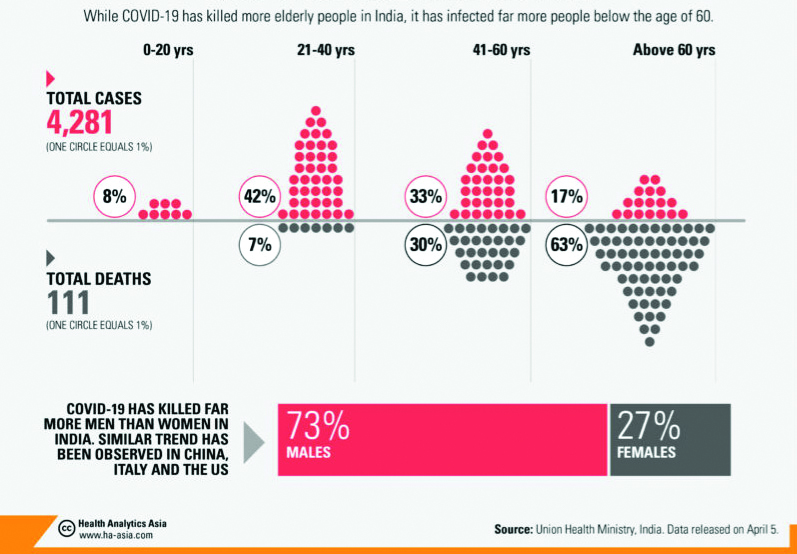
Environment
Climate-COVID-19 outbreaks in Wuhan, China suggest that the onset of these outbreaks was associated with high-relative humidity and low temperature. At 4°C, COVID-19 virus persists for approx. one month, inactivation occurs more rapidly when the humidity level increases more than 20°C [36].
Mode of Transmission
Initially, the suspected cases were found in Wuhan seafood market and identified as fever, with respiratory symptoms. A travel history or contact with people from Wuhan within two weeks and travel history of exposure to wildlife. Mainly human-to-human transmission identified [37,38].
The spread occurs mainly through respiratory droplets (when a sick person coughs), close contact and from fomites. The virus remains stable for several hours to days in aerosols and on surfaces, according to a new study from National Institutes of Health, CDC. They had found that virus was detectable in aerosols for few hours on copper, cardboard and few days on plastic and stainless steel [39].
The Chinese authorities reported that the possible aerosol transmission occurs in a closed environment with long-term exposures to high concentration of aerosols found mainly in ICUs and CCUs [40].
Clinical Features
According to CDC, people with confirmed COVID-19 presents with fever, cough and shortness of breath. The clinical features of illness are varies from no symptoms or mild respiratory symptoms to severe along with acute respiratory distress syndrome (ARDS), rapidly progressive pneumonia, multi-organ failure resulting in death or septic shock [41].
Diagnosis
By medical history
By physical examination
By lab tests of blood, sputum, a sample from a throat swab, or other respiratory specimens
Imaging examination
Medical History
According to the US CDC and WHO, people meeting the following criteria’s should be tested for COVID-19 [42].
People who had a history of recent international travel (within 14 days with respiratory symptoms.
Have a history of close contact (social contact, household contact and close-setting contacts).
Healthcare workers involved in treatment of lab confirmed cases of COVID-19.
Physical Examination
Patients with mild symptoms may not show positive signs and patients in severe condition may present with weakened breath sounds or shortness of breath, moist rales in lungs, increased or decreased tactile speech tremor and dullness in percussion.
Laboratory Test
According to CDC, two viral tests are available nucleic acid or antigen tests. Viral testing for SARS-CoV-2 is considered to be diagnostic when performed in symptomatic patients [43].
Sample Collection [44]:
1. Upper Respiratory Tract Specimen
a. Nasopharyngeal swabs
b. Oropharynageal swabs
2. Lower Respiratory Tract Specimen
c. Sputum
d. Bronchoalveolar lavage
e. Tracheal aspirate
Lower respiratory tract specimens are preferred over upper respiratory tract specimen for detecting SARS-CoV-2.
Patient should be re-sampled, if the initial test for COVID-19 comes negative and additional specimen may be collected such as blood, urine, and stool for COVID-19 testing [45,46].
Also, saliva for serial saliva viral load can be used [47].
Role of ICMR in Establishing Diagnosis of COVID-19 [3]
The ICMR-National Institute of Virology (NIV), Pune functions as the resource centre for the VRDL network and is responsible for providing technical training [Table/Fig-5].
Showing laboratory testing organogram.
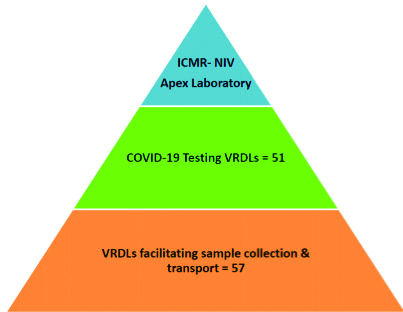
India made test kit approved by (Mylab, Pune) PCR test 100 per kit. Currently, Pool testing of the samples has been done to identify the cases rapidly.
Storage and Transport of Samples
For transport of samples for viral detection, use Viral Transport Medium (VTM) containing antifungal and antibiotic supplements. Samples should be transported under cold chain (≤ 4 degrees) and with proper labeling on each specimen container.
Handling and processing specimens should be preferred in accordance with national biological safety guidelines [48].
Imaging Examination/Imaging Features of CT
Ground glass density shadows in both lungs [49].
Case Definitions of Covid-19
According to WHO, the case definitions of COVID-19 are:[50]
Suspected Case
A. Patient with severe acute respiratory infection (fever, cough, and requiring admission to hospital), and with no other aetiology that fully explains the clinical presentation and a history of travel to or residence in China during the 14 days prior to symptom onset,
OR
B. Patient with any acute respiratory illness and at least one of the following during the 14 days prior to symptom onset and contact with a confirmed or probable case of COVID-19 infection within 14 days prior to symptom onset.
Probable Case
A suspect case for whom testing for SARS-CoV-2 is unresolved.
Confirmed Case
A person with laboratory confirmation of COVID -19 infections. Apart from presence or absence of COVID-19 signs and symptoms.
Prevention
A 14-day health observation period or quarantine period should be advised to those persons who had close contact and suspicious exposure. The period starts from the last day of contact with the suspicious environmental exposure or from the contact with COVID-19 infected patients [51].
Treatment
Supportive Treatment [
52]
Maintain Airway, Breathing and Circulation.
Ventilation, if required (If Po2 <55%)
Isolation to prevent spread
Correction of electrolyte Imbalance
Correction of temperature
Drugs
Few drugs are found to be effective in the treatment of COVID-19 namely, Lopinavir-Ritonavir [53], Favilavir [54], Remdesivir [55], Hydroxychloroquine [56], and newly identified Ivermectin.
Vaccines
MERS-CoV Vaccine [57]
Three potential MERS-CoV vaccine candidates have progressed to phase one clinical trials.
A DNA vaccine (GLS-5300)
Two viral vector-based vaccine (MVA-MERS-S and MERS001)
mRNA-1273 [58]
This is a phase I, open-label, and dose-ranging clinical trial among adults, 18 to 55 years of age.
Conclusion(s)
Newly identified disease agent SARS-CoV-2 has infected one million roughly around the world. With international lockdown and individual countries efforts the spread of the disease has been slowed down but in spite of the best global efforts we are still not able to contain the disease. While several drug trials are ongoing, there is currently no proof that any drug can cure or prevent from COVID-19.
[1]. Novel Coronavirus- China [Internet]. World Health Organisation. 2020 [cited 30 January 2020]. Available from: http://www.who.int/csr/don/12-january-2020-novel-coronavirus-china/en/ [Google Scholar]
[2]. A comprehensive timeline of the new coronavirus pandemic, from China’s first case to the present [Internet]. Business Insider. 2020 [cited 1 February 2020]. Available from: https://www.businessinsider.com/coronavirus-pandemic-timeline-history-major-events-2020-3 [Google Scholar]
[3]. ICMR. Press release on-Note on COVID-19 Laboratory preparedness in India. Published on 06, March 2020 [cited 04 April 2020]. Available from: https://main.icmr.nic.in/sites/default/files/press_realease_files/ICMR_PressRelease_COVID_19.pdf [Google Scholar]
[4]. (COVID-19) C, Health E, Disease H, Disease L, Management P, Conditions S, et al. Strains of Coronavirus [Internet]. WebMD. 2020 [cited 30 April 2020]. Available from: https://www.webmd.com/lung/coronavirus-strains [Google Scholar]
[5]. CDC, Coronavirus disease (COVID-19) [Internet]. 2020 [cited 2 February 2020]. Available from: https://www.cdc.gov/corona [Google Scholar]
[6]. Novel Coronavirus- China Disease outbreak news: Update. Jan 2020 [Internet] World Health Organisation. 2020 [cited 2 February 2020]. Available from: https://www.who.int/csr/don/12-january-2020-novel-coronavirus-china/en/ [Google Scholar]
[7]. [Internet]. Cdc.gov. 2020 [cited 1 February 2020]. Available from: https://www.cdc.gov/coronavirus/2019-ncov/locations-confirmed-cases.html#map [Google Scholar]
[8]. Rasmussen SA, Smulian JC, Lednicky JA, Jamieson DJ, Coronavirus Disease 2019 (COVID-19) and pregnancy: What obstetricians need to know. February 2020 American Journal Obsestrics Gynaecology [cited 12 July 2020] 222(5):418Available from: https://www.ajog.org/article/S0002-9378%2820%2930197-6/fulltext [Google Scholar]
[9]. Pullano G, Pinotti F, Valdano E, Boëlle P, Poletto C, Colizza V, Novel coronavirus (2019-nCoV) early-stage importation risk to Europe, January 2020 Eurosurveillance [Internet] 2020 [cited 1 February 2020] 25(4)Available from: https://www.eurosurveillance.org/content/10.2807/1560-7917.ES.2020.25.4.200005710.2807/1560-7917.ES.2020.25.4.200005732019667 [Google Scholar] [CrossRef] [PubMed]
[10]. Novel coronavirus (2019-nCoV). Situation report-17 [Internet]. World Health Organisation. 2020 [cited 6 February 2020]. Available from: https://www.who.int/docs/default-i/coronaviruse/situation-reports/20200207-sitrep-17-ncov.pdf?sfvrsn=fa644293_2 [Google Scholar]
[11]. Experience [Internet]. Experience.arcgis.com. 2020 [cited 4 March 2020]. Available from: https://experience.arcgis.com/experience/685d0ace521648f8a5beeeee1b9125cd [Google Scholar]
[12]. Press Information Bureau Government of India Ministry of Health and Family Welfare. [Internet]. Pib.gov.in. 2020 [cited 2 March 2020]. Available from: https://pib.gov.in/newsite/PrintRelease.aspx?relid=197738 [Google Scholar]
[13]. Novel Corona Virus | Ministry of Health and Family Welfare | GOI [Internet]. Main.mohfw.gov.in. 2020 [cited 30 March 2020]. Available from: https://main.mohfw.gov.in/diseasealerts/novel-corona-virus [Google Scholar]
[14]. WHO South east Asia, India Situation report 7 [Internet]. Who.int. 2020 [cited 30 March 2020]. Available from: https://www.who.int/docs/default-i/wrindia/situation-report/india-situation-report-7.pdf?sfvrsn=c883d0c2_2 [Google Scholar]
[15]. WHO South east Asia, India Situation report 8. [Internet]. Who.int. 2020 [cited 30 March 2020]. Available from: https://www.who.int/docs/default-i/wrindia/situation-report/india-situation-report-8.pdf?sfvrsn=c883d0c2_2 [Google Scholar]
[16]. MoHFW | Home [Internet]. Mohfw.gov.in. 2020 [cited 3 June 2020]. Available from: https://www.mohfw.gov.in/ [Google Scholar]
[17]. Cui J, Li F, Shi Z, Origin and evolution of pathogenic coronaviruses Nature Reviews Microbiology [Internet] 2018 [cited 30 March 2020] 17(3):181Available from: https://www.ncbi.nlm.nih.gov/pubmed/3053194710.1038/s41579-018-0118-930531947 [Google Scholar] [CrossRef] [PubMed]
[18]. Shereen M, Khan S, Kazmi A, Bashir N, Siddique R, COVID-19 infection: Origin, transmission, and characteristics of human coronaviruses Journal of Advanced Research [Internet] 2020 [cited 10 June 2020] 24:91-98.Available from: https://doi.org/10.1016/j.jare.2020.03.00510.1016/j.jare.2020.03.00532257431 [Google Scholar] [CrossRef] [PubMed]
[19]. Zhou P, Yang XL, Wang XG, Hu B, Zhang L, Zhang W, Discovery of a novel coronavirus associated with the recent pneumonia outbreak in humans and its potential bat origin Published in Nature doi: 10.1038/s41586-020-2012-7. Available from: www.biorxiv.org › content10.1038/s41586-020-2012-732015507 [Google Scholar] [CrossRef] [PubMed]
[20]. Chen Y, Liu Q, Guo D, Emerging coronaviruses: Genome structure, replication, and pathogenesis Journal of Medical Virology [Internet] 2020 [cited 30 March 2020] 92(4):418-23.Available from: https://www.ncbi.nlm.nih.gov/pubmed/3196732710.1002/jmv.2568131967327 [Google Scholar] [CrossRef] [PubMed]
[21]. Chan J, Yuan S, Kok K, To K, Chu H, Yang J, A familial cluster of pneumonia associated with the 2019 novel coronavirus indicating person-to-person transmission: A study of a family cluster The Lancet [Internet] 2020 [cited 30 March 2020] 395(10223):514-23.Available from: https://www.thelancet.com/journals/lancet/article/PIIS0140-6736(20)30154-9/fulltext10.1016/S0140-6736(20)30154-9 [Google Scholar] [CrossRef]
[22]. Morales R, Glaciation History Repeating Itself Science 1999 283(5399):141cited on 30 March 2020]10.1126/science.283.5399.141c [Google Scholar] [CrossRef]
[23]. Hu B, Ge X, Wang L, Shi Z, Bat origin of human coronaviruses Virology Journal [Internet] 2015 [cited 11 March 2020] 12(1):3Available from: http://virologyj.biomedcentral.com10.1186/s12985-015-0422-126689940 [Google Scholar] [CrossRef] [PubMed]
[24]. Fan Y, Zhao K, Shi Z, Zhou P, Bat Coronaviruses in China Viruses [Internet] 2019 [cited 2 April 2020] 11(3):210Available from: http://www.mdpi.com/journal/viruses10.3390/v1103021030832341 [Google Scholar] [CrossRef] [PubMed]
[25]. de Wit E, van Doremalen N, Falzarano D, Munster VJ, SARS and MERS: Recent insights into emerging coronaviruses Nature Reviews Microbiology [Internet] 2016 [cited 2 April 2020] 14(8):523-34.Available from: http://pubmed.ncbi.nlm.nih.gov10.1038/nrmicro.2016.8127344959 [Google Scholar] [CrossRef] [PubMed]
[26]. WHO. Emergencies/Diseases/Corona virus disease 2019/Advice for public [Internet]. Who.int. 2020 [cited 4 April 2020]. Available from: https://www.who.int/emergencies/diseases/novel-coronavirus-2019/advice-for-public [Google Scholar]
[27]. Coronavirus Diseases 2019 (COVID-19). Prevent getting sick. How to protect. [Internet]. cdc.gov. 2020 [cited 5 April 2020]. Available from: https://www.cdc.gov/coronavirus/2019-ncov/hcp/caring-for-patients.htm [Google Scholar]
[28]. Chen H, Juanjuan G, Wang C, Luo F, Yu X, Zhang W, Clinical characteristics and vertical transmission potential of 2019-nCoV infection in patients with pregnancy SSRN Electronic Journal [Internet] 2020 [cited 4 April 2020] (395):89Available from: https://www.thelancet.com/journals/lancet/article/PIIS0140-6736(20)30360-3/fulltext [Google Scholar]
[29]. China’s National Health Commission news conference on coronavirus [Internet]. Aljazeera.com. 2020 [cited 4 April 2020] Available from: https://www.aljazeera.com/news/2020/01/chinas-national-health-commission-news-conference-coronavirus-200126105935024.html [Google Scholar]
[30]. Centers for Disease Control and Prevention. 2020. Coronavirus Disease 2019 (COVID-19)- Symptoms [Internet]. Cdc.gov. 2020 [cited 6 April 2020]. Available from: https://www.cdc.gov/coronavirus/2019-ncov/about/symptoms.html [Google Scholar]
[31]. Coronavirus Incubation Period (COVID-19 Incubation Period). (2020). [Internet]. 2020 [cited 7 April 2020]. Available from: https://virusncov.com/covid19-incubation-period [Google Scholar]
[32]. Wang C, Horby PW, Hayden FG, Gao GF, A novel coronavirus outbreak of global health concern The Lancet [Internet] 2020 [cited 5 April 2020] 395(10223):470Available from: https://www.thelancet.com/journals/lancet/article/PIIS0140-6736(20)30185-9/fulltext10.1016/S0140-6736(20)30185-9 [Google Scholar] [CrossRef]
[33]. Q&A on coronaviruses (COVID-19) [Internet]. Who.int. 2020 [cited 4 April 2020]. Available from: https://www.who.int/news-room/q-a-detail/q-a-coronaviruses [Google Scholar]
[34]. Dong Y, Xi Mo, Yabin Hu, Xin Qi, Jiang F, Jiang Z, Clinical manifestations of COVID-19 appear to be less severe in children [Internet] Healio.com 2020 [cited 17 March 2020] Available from: https://www.healio.com/pediatrics/emerging-diseases/news/online/%7Bb9aa4835-098b-4a42-aaf2-1da9a9f64cc9%7D/clinical-manifestations-of-covid-19-appear-to-be-less-severe-in-children [Google Scholar]
[35]. Khurana D, 63% of COVID-19 deaths in India are of 60+ age group | Health Analytics Asia [Internet] Ha-asia.com 2020 [cited 19 June 2020] Available from: https://www.ha-asia.com/63-of-covid-19-deaths-in-india-are-of-60-age-group/ [Google Scholar]
[36]. Coronavirus: Symptoms Flu And Climate Change [Internet]. | WhatsOrb. 2020 [cited 4 April 2020]. Available from: https://www.whatsorb.com/climate/corona-virus-flu-and-climate-change-is-there-a-connection [Google Scholar]
[37]. Phan LT, Nguyen TV, Luong QC, Nguyen TV, Nguyen HT, Le HQ, Importation and human-to-human transmission of a novel coronavirus in Vietnam New England Journal of Medicine [Internet] 2020 [cited 31 March 2020] 382(9):872Available from: http://www.ncbi.nlm.nih.gov/pubmed/3199107910.1056/NEJMc200127231991079 [Google Scholar] [CrossRef] [PubMed]
[38]. Coronavirus Disease 2019 [Internet]. Centers for Disease Control and Prevention. 2020 [cited 3 April 2020]. Available from: https://www.cdc.gov/media/releases/2020/p0130-coronavirus-spread.html [Google Scholar]
[39]. NIH/National Institute of Allergy and Infectious Diseases: New coronavirus stable for hours on surfaces: SARS-CoV-2 stability similar to original SARS virus [Internet]. 2020 Science Daily. Science Daily, [cited 17 June 2020] Available from: www.sciencedaily.com/releases/2020/03/200317150116.htm [Google Scholar]
[40]. Airborne spread of COVID-19 not reported so far, says WHO official [Internet]. Deccan Herald. 2020 [cited 24 June 2020]. Available from: https://www.deccanherald.com/science-and-environment/airborne-spread-of-covid-19-not-reported-so-far-says-who-official-816983.html [Google Scholar]
[41]. Coronavirus Disease 2019 [Internet]. Centers for Disease Control and Prevention. 2020. Symptoms of coronavirus [cited 15 June 2020]. Available from: https://www.cdc.gov [Google Scholar]
[42]. Novel Coronavirus Information Center [Internet]. Elsevier Connect. 2020 [cited 7 April 2020]. Available from: https://www.elsevier.com/connect/coronavirus-information-center [Google Scholar]
[43]. Coronavirus Disease 2019 (COVID-19) [Internet]. Centers for Disease Control and Prevention. 2020 [cited 25 June 2020]. Available from: https://www.cdc.gov/coronavirus/2019-ncov/hcp/testing-overview.html#changes [Google Scholar]
[44]. Information for Laboratories about Coronavirus (COVID-19) [Internet]. Centers for Disease Control and Prevention. 2020 [cited 19 March 2020]. Available from: https://www.cdc.gov/coronavirus/2019-nCoV/lab/guidelines-clinical-specimens.html [Google Scholar]
[45]. Global Surveillance for human infection with coronavirus disease (COVID-19) [Internet]. Who.int. 2020 [cited 30 March 2020]. Available from: https://www.who.int/publications-detail/global-surveillance-for-human-infection-with-novel-coronavirus-(2019-ncov) [Google Scholar]
[46]. Laboratory testing for 2019 novel coronavirus (2019-nCoV) in suspected human cases [Internet]. Who.int. 2020 [cited 31 March 2020]. Available from: https://www.who.int/publications-detail/laboratory-testing-for-2019-novel-coronavirus-in-suspected-human-cases-20200117 [Google Scholar]
[47]. To KKW, Tsang OTY, Yip CCY, Chan KH, Wu TC, Chan JMC, Consistent detection of 2019 novel coronavirus in saliva Clinical Infectious Diseases [Internet] 2020 [cited 27 March 2020] Available from: https://academic.oup.com/cid/article/doi/10.1093/cid/ciaa149/573426510.1093/cid/ciaa14932047895 [Google Scholar] [CrossRef] [PubMed]
[48]. Biosafety in Microbiological and Biomedical Laboratories. 5th Edition. U.S. Department of Health and Human Services Public Health Service Centers for Disease Control and Prevention National Institutes of Health [Internet]. 2020 [cited 5 May 2020]. Available from: https://www.cdc.gov/labs/pdf/cdc-Biosafet [Google Scholar]
[49]. Jin Y, Cai L, Cheng Z, Cheng H, Deng T, Fan Y, A rapid advice guideline for the diagnosis and treatment of 2019 novel coronavirus (2019-nCoV) infected pneumonia (standard version) Military Medical Research [Internet] 2020 [cited 5 April 2020] 7(1):8Available from: https://www.ncbi.nlm.nih.gov [Google Scholar]
[50]. WHO. Global surveillance for COVID-19 caused by human infection with COVID-19 virus. Interim Guidance. [Internet]. who.in. 2020 [cited 5 April 2020]. Available from: https://www.who.int/publications-detail/global-surveillance-for-human-infection-with-novel-coronavirus-(2019-ncov [Google Scholar]
[51]. Disease commodity package-Novel Coronavirus (COVID-19) [Internet]. Who.int. 2020 [cited 5 April 2020]. Available from: https://www.who.int/publications-detail/disease-commodity-package---novel-coronavirus-(ncov) [Google Scholar]
[52]. Technical guidance [Internet]. Who.int. 2020 [cited 5 April 2020]. Available from: https://www.who.int/emergencies/diseases/novel-coronavirus-2019/technical-guidance [Google Scholar]
[53]. Cao B, Wang Y, Wen D, Liu W, Wang J, Fan G, A Trial of Lopinavir- Ritonavir in Adults Hospitalised with Severe COVID-19 The New England Journal of Medicine Published on 18 March 2020 [cited 5 April 2020]. Available from https://www.nejm.org/doi/full/10.1056/NEJMoa2001282 [Google Scholar]
[54]. Favilavir- first anti COVID-19 drug approved [Internet]. Sagisag.com. 2020 [cited 2 April 2020]. Available from: https://www.sagisag.com/article/2101/news/favilavir-first-anti-covid19-drug-approved [Google Scholar]
[55]. Remdesivir most promising COVID-19 drug, say researchers [Internet]. Drug Target Review. 2020 [cited 3 April 2020]. Available from: https://www.drugtargetreview.com/news/58608/remdesivir-most-promising-covid-19-drug-say-researchers/ [Google Scholar]
[56]. ICMR Interim Guidance on Recommendation for empiric use of hydroxy-chloroquine for prophylaxis of SARS-CoV2 infection. [Internet] 2020 [cited 3 April 2020] Available from: https://www.icmr.nic.in/content/covid-19 [Google Scholar]
[57]. Yong C, Ong H, Yeap S, Ho K, Tan W, Recent advances in the vaccine development against middle east respiratory syndrome-coronavirus Frontiers in Microbiology 2019 :1010.3389/fmicb.2019.0178131428074 [Google Scholar] [CrossRef] [PubMed]
[58]. NIH.U.S National Library of Medicine. Safety and Immunogenicity study of 2019-nCoV vaccine (mRNA-1273) to prevent SARS-CoV2 Infection. [Internet]. National Institutes of Health (NIH). 2020 [cited 4 April 2020]. Available from: https://www.nih.gov/coronavirus [Google Scholar]